Revisiting Integration: A Proposed Framework in the Light of Competency-Based Medical Education in Indian Context
Tripti K Srivastava Waghmare1, Archana Dhok2, Lalitbhushan S Waghmare3
1 Professor, Department of Physiology, Jawaharlal Nehru Medical College, DMIMS (DU), Wardha, Maharashtra, India.
2 Professor and Head, Department of Biochemistry, Jawaharlal Nehru Medical College, DMIMS (DU), Wardha, Maharashtra, India.
3 Professor, Department of Physiology, Jawaharlal Nehru Medical College, DMIMS (DU), Wardha, Maharashtra, India.
NAME, ADDRESS, E-MAIL ID OF THE CORRESPONDING AUTHOR: Tripti K Srivastava Waghmare, Professor, Department of Physiology, JNMC, Sawangi (M), Wardha-442001, Maharashtra, India.
E-mail: drtriptisrivastava@gmail.com
Various methods of Integration (Temporal co-ordination, Sharing, Nesting and Co-relation) recommended in the revised curriculum of Undergraduate Competency Based Medical Education (CBME) from 2019 academic session onwards is discussed hereby. A brief description of these methods and recommended frameworks for planning such integration sessions are suggested. Medical colleges can plan and place integration of contents across various phases of curriculum on the basis of suggested frameworks, depending on factors like the targeted areas of integration, views and experience of teachers, organisational structure and course outcomes.
Nesting, Sharing, Temporal coordination
Introduction
As per Graduate Medical Education Regulation (GMER-amendment 2019), the undergraduate medical curriculum is revised to Competency-based from academic year 2019 onwards [1]. One of the salient features of this revised curriculum is emphasis on integration of contents, keeping the subject specific specialities intact. The aim of this review paper is to revisit the concept of ‘Integration’ and its proposed methods in a competency based curriculum of undergraduate medical education. The manuscript also proposes frameworks for Sharing, Nesting and Co-relation that can be considered by Medical schools while planning such integration sessions and can act as a ready reference tool for teachers and students alike. The reference search for this manuscript was carried out electronically from articles and books viz., PubMed, Medline, Scopus, Index Copernicus and Google Scholar focussing on methods of integration in medical education and related framework for its operability.
The need of essential shift from traditional curriculum to SPICES model (Student-centred learning, Problem-based learning, Integrated teaching, Community-based education, Elective programs and a Systemic approach) has been emphasised in literature so as to integrate Health-Illness-Management concept [2]. In a competency based curriculum, integration remains the mainstay to give it a valid stance. It is a learning experience that allows the learner to perceive relationships from isolated blocks of knowledge and establish relationships for its proper application in health care [3]. The idea is to help the learner with an integrated knowledge base, ability to apply skills, faster retrieval of information and more room for curricular exploration.
The new Competency based undergraduate Medical Education applies the principles of Integration to the extent that it retains the strengths of systems based education and assessment while providing experiences that will allow learners to integrate concepts. Wherever possible, GMER-2019 recommends sharing or correlating topics by using an integration or linker session within the curriculum. The objective is to ensure achievement of phase specific objectives wherein integration is embedded to provide adequate recall and conceptual understanding of the clinical/basic science applications. It is recommended that undergraduate Medical Education should be organised in such a way that it brings together various aspects of the curriculum into meaningful association to focus upon broad areas of study [1].
The hallmark, as enshrined in the revised curriculum is the suggested methods of integration viz., Temporal co-ordination, Sharing, Nesting and Co-relation [4]. These modes are in synchrony with the ones envisaged in the taxonomy of 11 step ladder by Harden RM. The proposed methods balance the thoroughness of independent subjects and association of concepts [5] between subjects across various professional years.
Nesting and Co-relation, as integration methods, support the learning theory by Piaget et al., that prior cognitive structures are an important part of cognitive development to meaningfully acquire new information or concepts. Ausubel also postulated that meaningful learning occurs when new information is subsumed by existing relevant concepts, and these concepts undergo further change and growth [6,7]. Hence, the cognitive structures so developed, via these integration methods can serve as a foundation stone for further knowledge and higher order thinking skills.
Integration in CBME: Specifics and Proposed Framework
The GMER (amendment 2019) suggests four methods viz., Temporal co-ordination, Sharing, Nesting and Co-relation for all phases of curriculum, wherein Temporal coordination should occupy almost 80% of the syllabus and remaining 20% should be for other three types [1].
Temporal co-ordination: The approach is often referred to as ‘Concurrent’, ‘Parallel’ or ‘Aligned’ teaching. The time table is formulated in such a way that topics within the subjects or disciplines which are related are scheduled at the same time. Students are taught concepts of different subjects separately, however, similar areas within different subjects are taught at the same time [2]. A major concern with this approach is that it is left to the learners to establish relationships between contents of different subject areas. Temporal co-ordination is a good starter for a more defined integrated curriculum, and may be considered independently rather than a type of integration. It helps teachers to co-ordinate amongst different subject areas. An example of temporal co-ordination can be teaching of cardiac physiology aligned with teaching Anatomy of heart. [Table/Fig-1] depicts the concept of temporal alignment wherein related topics/themes of different subjects in 1st phase of medical curriculum are taught in the same time frame.
Concept of Temporal coordination (Similar coloured blocks depict temporally coordinated topics within different subjects of a common phase).
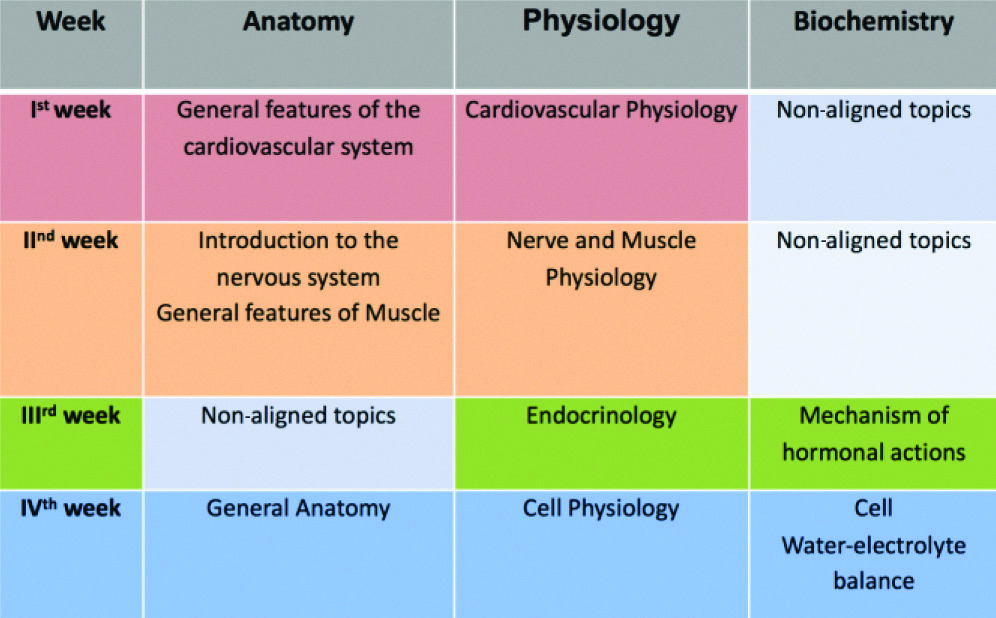
Sharing: In this method, shared planning and teaching occurs in two or more disciplines involving over-lapping concepts or ideas emerge as organising elements [8]. The focus is on shared elements between two subjects/disciplines. Generally, this applies to complementary courses wherein dealing with the contents jointly makes more sense than teaching in isolated compartments. This approach also prevents overlap while dealing with objectives of the course and minimises redundancy. The revised curriculum prescribes this method of integration for MBBS curriculum to emphasise the integrated nature of Medical science for considerable portion and to avoid overlaps that is substantive in a traditional curriculum. The concept is to share common objectives of different subjects within same phase and deal with them jointly. Sharing of common objectives also result in realisation of interrelationships, identify commonalities and present the larger picture to learners, rather than subject as tight compartments within a discipline. [Table/Fig-2] depicts sharing of common objectives in Anatomy and Physiology.
Concept of Sharing (Bold objectives are the ones shared between subjects of Anatomy and Physiology).
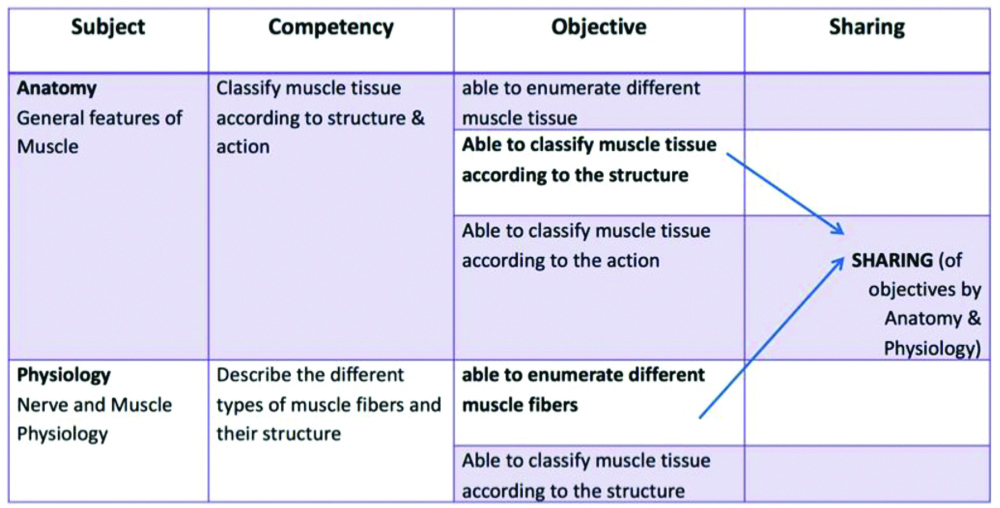
Template for Sharing [Table/Fig-3]: The template specifies the topic of Integration, Professional year, Primary subject and other subjects with which objectives are shared, targeted competency with details, shared objectives, their teaching learning and assessment methods, Learning resource material and references.
Sharing Module Template (Copyright no. L-86554/2019, DMIMS Integration module template, Dr Tripti K Srivastava, Dr Lalitbhushan Waghmare).
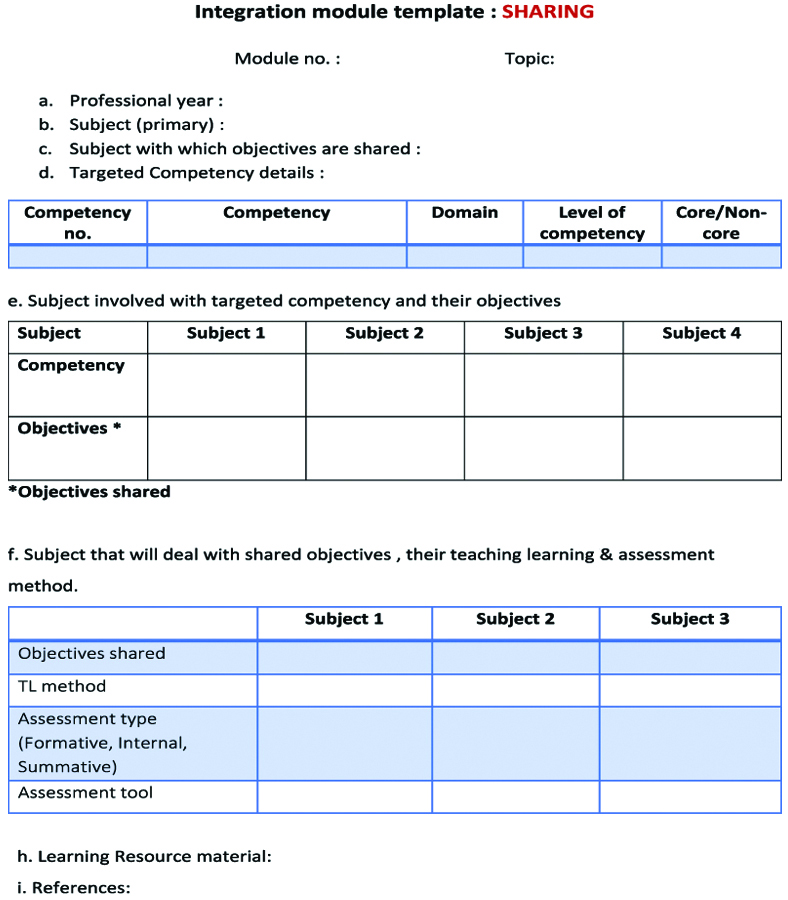
Nesting: Nesting is the fourth step in the integration ladder by Harden RM [2]. Here the teacher targets, within a subject-based course, skills relating to other subjects. Fogarty R described this as subject specific approach wherein objectives from other relevant subjects are dealt within the core subject to give a wholistic view [8]. The teachings essentially remain subject based, however; the broad goals of curriculum are considered for blending contents so as to recognise generic competencies in related learning domains. For instance; a course in Endocrine Physiology may Nest clinical symptoms, broad management protocols and social aspects in endocrinology that are generally dealt with subjects of Medicine and Preventive and Social Medicine. [Table/Fig-4] depicts the concept of nesting, one objective from the subject of Medicine while teaching Physiology.
Concept of Nesting (Table depicts an objective of Medicine from MBBS phase III being ‘Nested’ in Physiology of phase I MBBS), Comp: Competency.
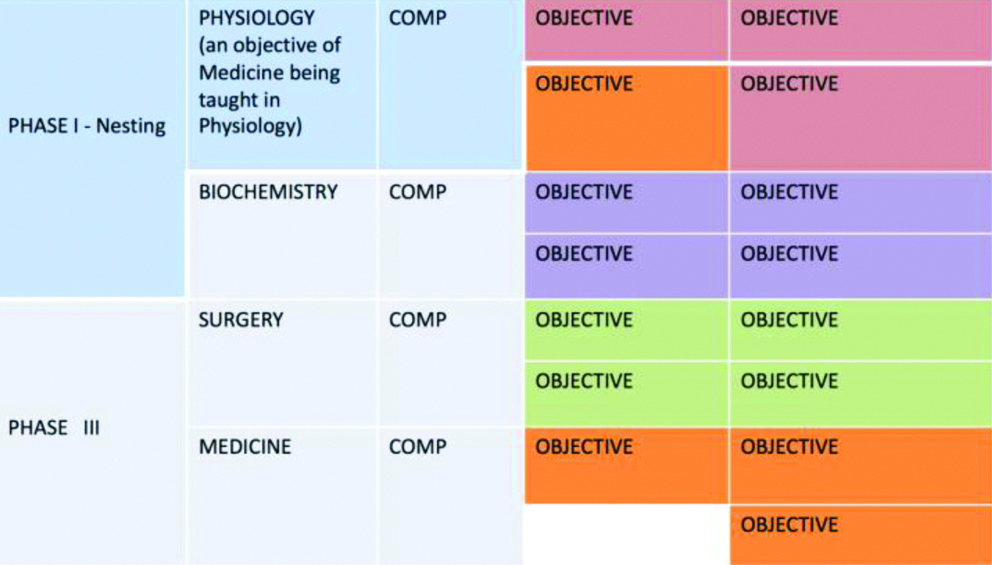
Template for Nesting [Table/Fig-5]: The template specifies the topic of Integration, Professional year, Targeted competency with its details, Primary subject and other subjects that are nested, objectives from other subjects that are nested, Learning resource material and references.
‘Nesting’ Module Template (Copyright no. L-86554/2019, DMIMS Integration module template, Dr Tripti K Srivastava, Dr Lalitbhushan Waghmare).
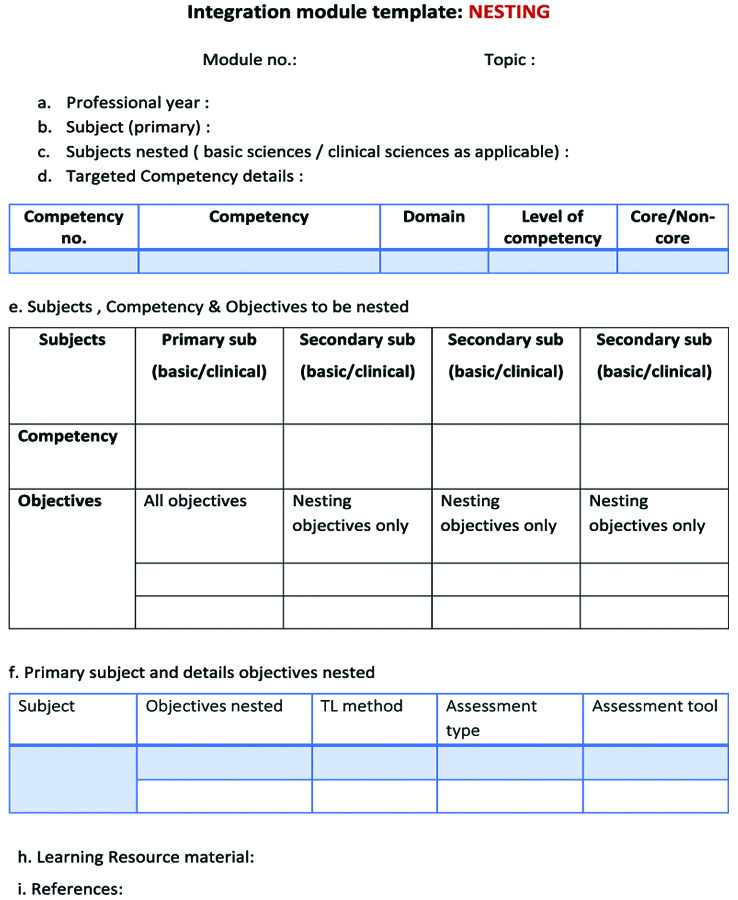
Co-relation: In Co-relation, the emphasis remains on subject specific contents with a common linking session that links all related subjects through a clinical case or a problem. Competencies across different subjects (horizontally and/or vertically) are connected with a linker. Linker is a session that allows the learner to link the concepts of aligned topics, traditionally taught in different subjects. It allows the learner to approach a clinical problem with varied angles that cuts across subject matter lines. Clinical cases can be used to integrate and link learning across disciplines. The linker can also be kind of a project or seminar that integrates these subjects, thus establishing a relationship between different subject areas. It can be referred to as a ‘Concomitant program’. [Table/Fig-6] depicts a ‘Linker’ case to connect the objectives of Microbiology, Pharmacology and Pathology.
Concept of Co-relation (the Linker is any clinical case, problem, scenario, seminar etc. that connects objectives of related subjects within same/across phases).
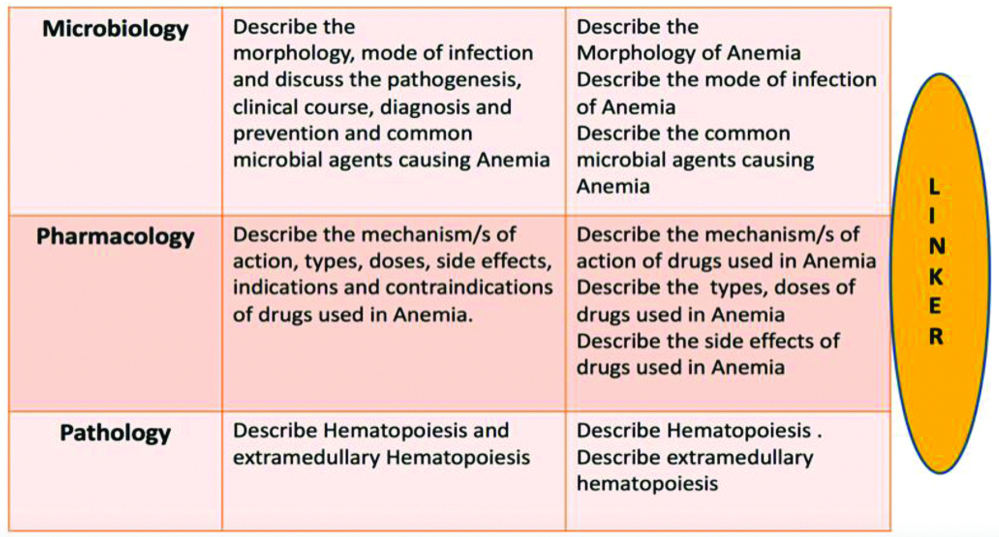
Template for Co-relation [Table/Fig-7]: The template of co-relation specifies the topic of Integration, Professional year, Targeted competency with its details, subjects co-related through a case/linker, proposed linker, objectives that are to be co-related through linker, their teaching learning and assessment methods, Learning resource material and references.
‘Co-relation’ Module Template (Copyright no. L-86554/2019, DMIMS Integration module template, Dr Tripti K Srivastava, Dr Lalitbhushan Waghmare).
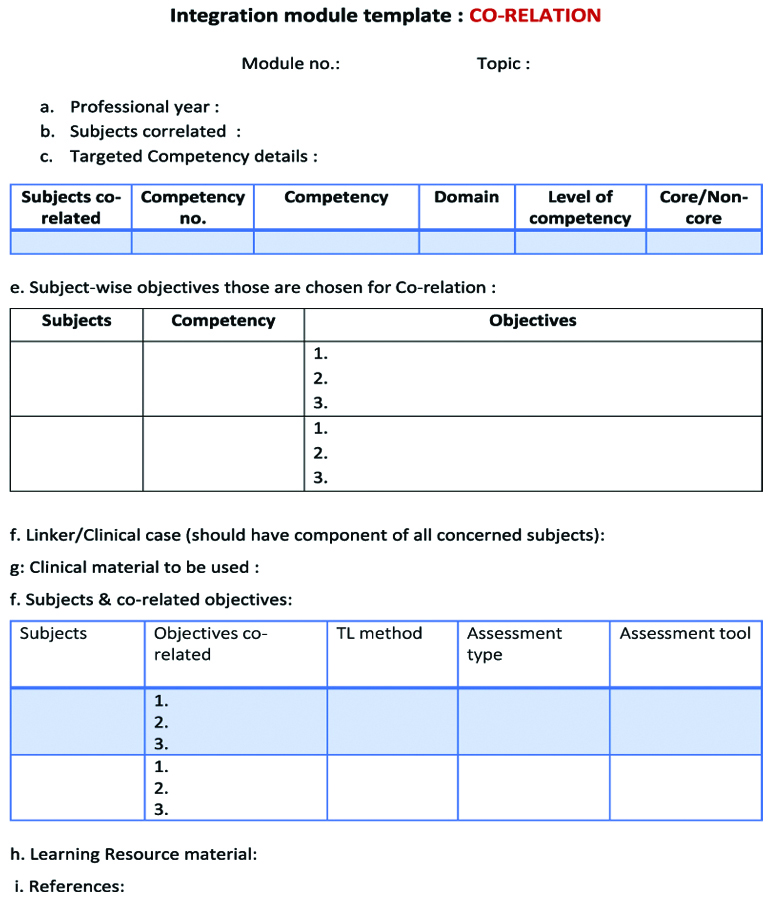
Limitation(s)
This review limits its vision to comprehend integration strategies, as envisaged in MCI document on Alignment and Integration and suggests certain frameworks for smooth implementation of the same. The various challenges in planning and execution of integration, that essentially involves different subjects, multiple objectives, multiple domains of learning and varied instructional strategies are not addressed in this review.
Implication(s)
The four strategies of integration viz., Temporal co-ordination, Sharing, Nesting and Co-relation are all aimed towards connecting pieces of information together and minimise overlaps within the curriculum for the learner. The three templates, as presented in this manuscript can guide the teachers to plan integration in a structured manner and help the learners to find the association between various learning objectives and domains that goes on to fulfil a broad competency within a curriculum. These frameworks can serve as a guide for teachers (Teaching for Understanding (TfU), supported by Perkins’ approach) [9] and learners as a ready reference document depicting integration of contents across the undergraduate medical curriculum.
Conclusion(s)
Integration is the key to holistic learning. It is reiterated that for a competency to materialise in its truest sense, integration of objectives across subjects and domains is the basic pre-requisite. The revised curriculum-CBME gives ample scope and space within curriculum to integrate contents, derive associations and establish relationships between isolated subject compartments. It offers a range of options for integration of contents aligned with the concept of Teaching for Understanding (TfU), supported by Perkins’ approach. The choice depends on factors like the targeted areas of integration, views and experience of teachers, organisational structure and course outcomes.
Author Declaration:
Financial or Other Competing Interests: None
Was Ethics Committee Approval obtained for this study? NA
Was informed consent obtained from the subjects involved in the study? NA
For any images presented appropriate consent has been obtained from the subjects. NA
Plagiarism Checking Methods: [Jain H et al.]
Plagiarism X-checker: May 02, 2020
Manual Googling: Jun 22, 2020
iThenticate Software: Aug 08, 2020 (11%)
[1]. https://www.mciindia.org/CMS/e-gazette (last accessed on 25th April 2020) [Google Scholar]
[2]. Harden RM, Sowden S, Dunn WR, Educational strategies in curriculum development: The SPICES modelMed Educ 1984 18(4):284-97.10.1111/j.1365-2923.1984.tb01024.x6738402 [Google Scholar] [CrossRef] [PubMed]
[3]. Shoemaker BJE, Integrative education: A curriculum for the twenty-first centuryOSSC Bulletin 1989 33(2):n2 [Google Scholar]
[4]. Medical Council of India. Alignment and Integration Module for Undergraduate Medical Education Program, 2019: pp. 01-34 [Google Scholar]
[5]. Harden RM, The integration ladder: A tool for curriculum planning and evaluationMed Educ 2000 34:551-55.10.1046/j.1365-2923.2000.00697.x10886638 [Google Scholar] [CrossRef] [PubMed]
[6]. Steadman M, Using classroom assessment to change both learning and teachingNew Directions for Teaching and Learning 1998 75:23-35.10.1002/tl.7503 [Google Scholar] [CrossRef]
[7]. Kwan F, (n.d.). Formative assessment: The one-minute paper vs. the daily quizJournal of Instructional Pedagogies 2011 5:01-08. [Google Scholar]
[8]. Fogarty R, How to integrate the curriculaPalatine, Illinois, IRI/Skylight Training and Publishing Inc 1991 [Google Scholar]
[9]. Perkins D, Making learning whole: How seven principles of teaching can transform education 2009 San FranciscoJossey-Bass [Google Scholar]